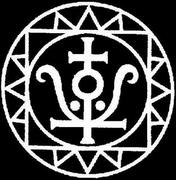Signs, symbols and rites
This way Alfieri considers the sign as self-expressive, meaning that he identifies it as a segment of the whole where the entire meaning is condensed. His new sign, taking on strong gesture values, conquers space, it becomes self protagonist and moves freely in it as enèrgeia (activity) rather than èrgon (piece of work). The space becomes the signs legitimate interlocutor, the sign aims to build a discourse with the space and goes beyond language.
This sign-discourse of Alfieri moves freely, reassumes the world, talks about it and becomes, at the same time, fact. But then it raises itself toward the dimension of the symbol. And here it is necessary to remember, along with Victor Turner, that if the sign is an analogous or shortened expression of a known thing, the symbol is the best possible expression of a relatively unknown yet existing fact. The new sign of Alfieri is not only the one that he traces with a brush, a pen or a pencil and puts in the middle of the surface of the base: it is not only a sign thought of and built. It’s also what he invents in the etymological meaning of the word that derives from the latin “invenire” and that means to find, to discover.
Here we have, the sign out in the open. Where? In the structures of the base that acts as a surface and that for Alfieri it is rigorously a paper one. A paper rich in fibres, that is lents itself to the skillful manipulation of the artist; a wet paper, scraped off, carved, soaked in colors, in earths, in dusts and in any other material; a paper that, in his hands, is transformed into a live thing where the signs, full of energy, or rather themselves energy, are vital elements, but also traces, wakes, memories.
The artist that works with paper and on paper, that manipulates it and transforms it in to space crossed by symbolic and sign energies, that exploits the intrinsic hylozoism of it (that is the material living nature), that transforms it into narrative fact, this artist is an alchemist whose action becomes a ritual. Alfieri’s works, in fact, are offered to the onlookers as ritual actions. Therefore , as it happens during a liturgy built on authentic symbols, on rites, on strong signs summaries of history and transcendence, so too in front of his works, we feel attracted towards a vortex of feelings above reason in which poetry, magic and other mysterious energies, that don't seem to belong to the world of the experience, meet and melt to generate an exaltation of absolute and of endlessness.
Armando Ginesi


